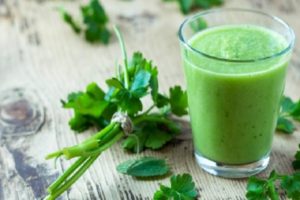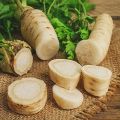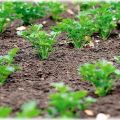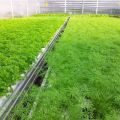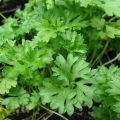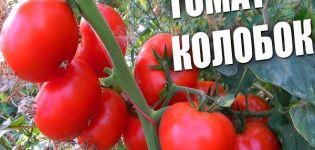Features of growing and caring for root parsley in the open field
Root parsley is a constant inhabitant of vegetable gardens. This culture is cold-resistant and unpretentious. With a little care, the summer resident provides himself with fragrant root crops for the winter.
A root spice to improve the taste of soups, salads. Independent dishes are prepared from it. For gardeners, root parsley-based dressings for first courses are popular. It is impossible to imagine a kitchen without the use of this fragrant plant.
The advantages of the root spice are long and varied storage. It can be frozen, salted, stored in the basement. The spicy root will retain its taste and consumer properties.

Features of growing root parsley
Growing parsley gardeners can cope with the root. But it is required to take into account the peculiarities of culture:
- the root crop prefers loose, breathable soils;
- to obtain even underground fruits, agrotechnics should be observed (watering, feeding, loosening);
- root seasoning is cultivated in a garden bed, in a greenhouse, on a windowsill (for forcing greens in winter).
Seed producers offer ample planting material. Varieties of aromatic root crops are popular among gardeners:
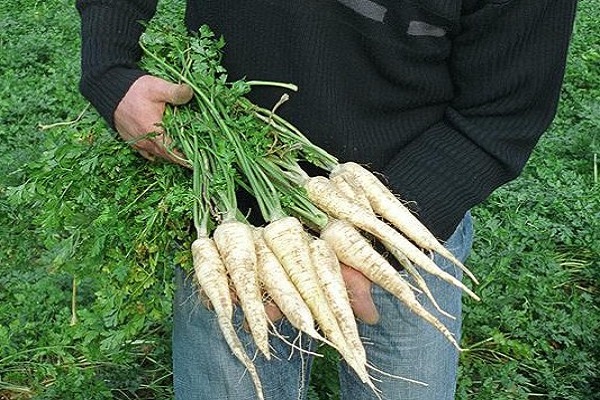
- Yielding (root length up to 20 cm, demonstrates resistance to diseases and pests);
- Alba (grows up to 290 g, does not have fine hairs on the main root, it is perfectly stored);
- The final (root (underground) part grows up to 200 g, evened fruits, delicate taste is revealed in conservation);
- Sugar (appreciated for the early ripening of the root part, grows up to 60 g, grayish-white color, sweet taste).
- Eagle (Dutch variety, leveled roots, grows up to 140 g, prized for its high yield and versatile root use).
When buying seeds, gardeners assess the ripening time, root yield, taste and options for use.

Landing dates
Root parsley is a cold-resistant plant. Planting in open ground is permissible as soon as the soil warms up to 4 degrees Celsius. This usually occurs immediately after thawing of the soil. Important not to miss planting time: parsley a lot of moisture is required for germination. Seeds will not germinate in overdried soil.
There is a lot of work in the garden in the spring. Sowing a cold-resistant crop can be done before winter. Root spice seeds will thrive when the weather is right.
For planting, you should choose a time 2-2.5 weeks before the onset of stable cold weather. The seeds take time to swell.But they shouldn't have time to germinate. Sowing is carried out only with dry seeds. With this method of planting material, it is recommended to take 30% more.

Choosing a landing site
To obtain the desired harvest of roots, you need to correctly choose a place for the ridge:
- Root parsley prefers loose (moisture-permeable and breathable) soils. Sandy loam, sod-podzolic and light loamy soils are ideal.
- The place should be well lit by the sun. In shaded areas, the roots grow small.
- The ridge should not be flooded: the parsley rots easily.
- Planting needs to be protected from cold northerly winds and drafts. It is a good idea to plant roots on the south side of buildings.
- Pay special attention to predecessors. The root crop gives an excellent harvest after squash, pumpkin, cucumber. It is undesirable to plant after umbrella (carrots, parsley, celery).
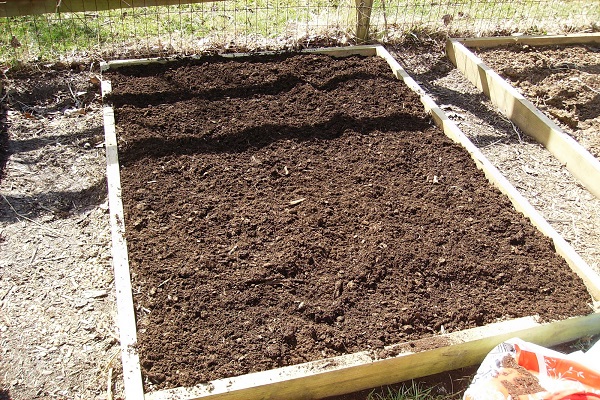
Remember: the seat must be prepared in advance. When planting a root crop in spring-autumn, with a podzimny sowing - in a month.
Sugar root parsley: growing in the open field
Sugar is the most popular variety of root spice among gardeners. It is loved for its early ripening, yield and special (sweet taste). When grown outdoors, the following conditions must be met:

- Before planting, it is forbidden to make compost or humus: the roots will coarsen and lose marketability.
- The soil should be filled with a mineral complex according to the manufacturer's instructions.
- Fertilizers should be applied when digging (on the bayonet of a shovel). At the same time, clean the ridge of weeds: they inhibit the root spice.
- Mark the rows at a distance of 20 cm from each other. Make grooves 2 cm deep.
- When planting in the spring, it is recommended to spill them with a warm solution of potassium humate.
- Plant the seeds 3-4 cm apart. Put 3 seeds in the hole (to avoid the absence of empty spaces).
- Sprinkle with soil, tamp.
- To preserve moisture (for spring planting), cover the ridge with lutrasil.
- Parsley takes a long time to sprout. Planting should be regularly moistened over a non-woven fabric.
After germination, one strong plant should be left. The rest needs to be weeded out.
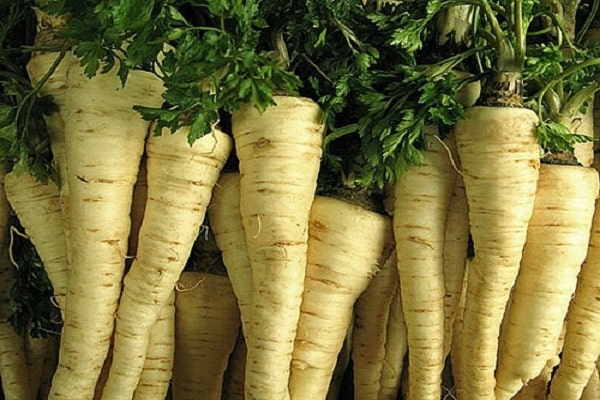
Growing parsley root at home
Some gardeners use root parsley for forcing greens at home during the winter. In this case, it is necessary to observe:
- Temperature conditions. Until emergence, 4-10 degrees Celsius, then 15-20.
- Humidity. The soil should be regularly moistened. But pouring the plant is not recommended: the root seasoning rots easily.
- Illumination. In room conditions, root parsley needs to be illuminated up to 16-18 hours.
- Top dressing. Fertilizers are applied at planting. When depressed, the plants are fed after cutting with a mineral complex.
When forcing greens from the roots, there is a possibility of a flower arrow.

Sugar root parsley: growing in a greenhouse
Many gardeners try grow parsley in a greenhouse or greenhouse... This requires free space. Sugar's advantage is early maturity. When sowing in winter, the crop is harvested prior to the placement of the main greenhouse crops.
Usually Sugar is planted in an unheated greenhouse when radiation increases: at the end of January. When a sudden cold snap sets in, it is recommended to cover the planting with dense lutrasil (60 g / square meter).
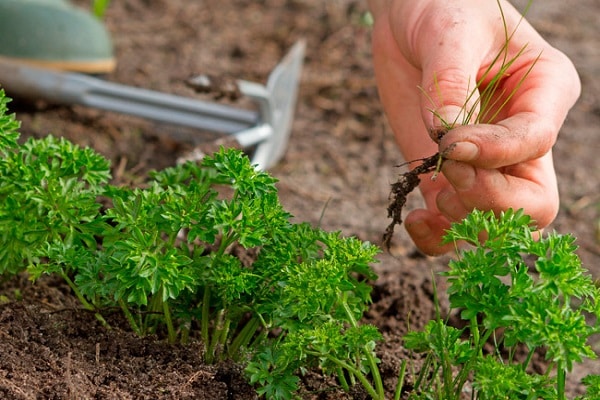
Care features
Parsley is an unpretentious plant. But the gardener will have to provide simple care for the root spice.
Watering rules
The fragrant root tolerates short-term drought. But the taste of the root crop deteriorates. The ridge should be moistened after the top layer has dried.
It is recommended to use warm water for irrigation. To do this, it is poured into containers in advance. Water the parsley in the morning or evening. In long rainy weather, the ridges should be covered with foil.

Top dressing
Before planting seeds of root spice, a complex of mineral fertilizers is introduced into the soil. After the emergence of seedlings, it is recommended to feed them with nitrogen fertilizer once. To do this, prepare an infusion of fermented herbs:
- fill the container with weeds without roots;
- to fill with water;
- close the lid and put in the sun;
- after the start of fermentation, dilute the infusion with water in a ratio of 1: 8 and use for feeding the parsley.
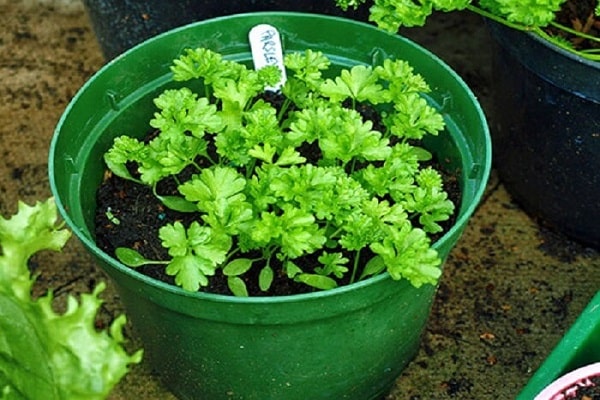
After the foliage grows 10-15 cm, mineral fertilizers should be applied. It is more convenient to use soluble ones. Further feeding does not make sense: parsley will look for nutrients in the upper soil layers. Does not form beautiful, even roots.
Possible diseases and pests of parsley root
Parsley is susceptible to several diseases:
- peronosporosis (leaves are affected by spots, then the tops dries up);
- white rot (roots hurt, they soften and disappear);
- white spot (spots form on the ground parts, then the tissues soften and rot);
- rust (the tops turn red and dry out).
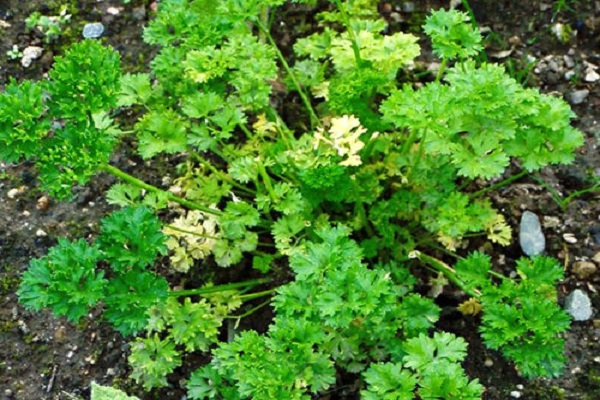
Diseases occur due to violations of the rules of care... Subject to agricultural technology, gardeners get a harvest of healthy tasty roots.
Pests
The greatest harm to plantings is caused by carrot flap... She lays eggs at the base of the root. The hatched larvae damage the plant.
For protection, it is recommended to dust the plantings with a mixture of ash and tobacco dust. It is useful during the summer of the insect to cover the ridges with lutrasil with a density of 17 g / square meter.

The second pest is aphids. It is seated by ants. To fight, anthills should be destroyed (in April) and the aphids should be washed off with a solution of green or tar soap.
From the carrot fly, plantings are sprayed with water with the addition of kerosene (a tablespoon per 1 liter). But with this method, the roots have an unpleasant smell and taste. Experienced gardeners get rid of the pest by planting onions and garlic next to parsley.

Harvesting and storage
The time to dig out the roots of parsley begins in early autumn. They are carefully pried with a pitchfork. This tool injures root crops least of all.
The dug out plants are shaken off the ground and dried in the sun for 2 hours. This procedure destroys harmful bacteria.
Then the tops are cut off. If you plan to forcing the greens in winter from the root, leave a stump of 1-2 cm. When laying for storage, cut off the growth point along with a part of the root crop. This will keep the parsley juicy.

In the refrigerator, the roots are stored in a perforated plastic bag. Some gardeners cover the root crop with wet sand and lower it into the cellar.
Harvested parsley retains its flavor and nutrients when frozen. The roots should be washed, chopped and folded into a container or bag. In the freezer, the root spice will taste great: the roots are ready to use within a year.

